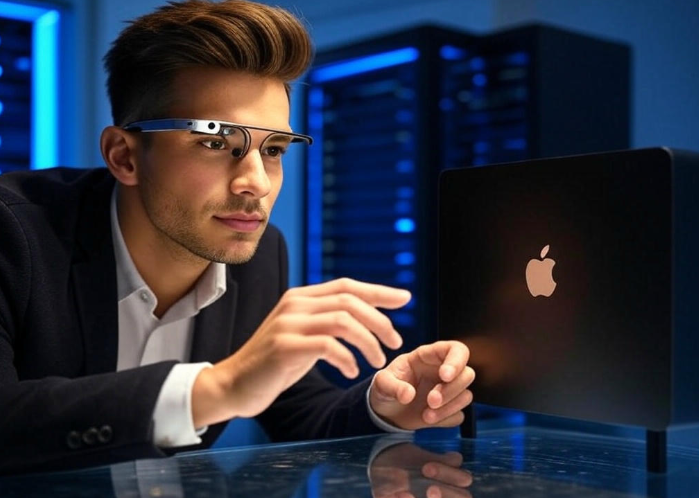Apple has long been a trailblazer in the tech industry, consistently pushing the boundaries of innovation with its seamless integration of hardware and software. On May 8, 2025, Bloomberg reported that Apple is developing specialized chips to power a new wave of devices, including its first smart glasses, next-generation MacBooks, and AI servers. This move signals Apple’s ambition to dominate emerging tech categories like augmented reality (AR) and artificial intelligence (AI), while further strengthening its ecosystem. Let’s explore what these new chips mean for Apple’s future, the competitive landscape, and the broader tech industry.
Apple’s Chip Strategy: A Legacy of Innovation
Apple’s journey into custom silicon began over a decade ago with the A-series chips for iPhones and iPads. The transition to Apple Silicon with the M-series chips for Macs, starting in 2020, marked a pivotal shift, allowing the company to optimize performance, power efficiency, and integration across its devices. Today, Apple’s silicon team is a cornerstone of its product development, enabling the company to differentiate itself from competitors who rely on third-party chipmakers like Intel or Qualcomm.
The latest development involves specialized chips tailored for specific use cases: low-power processors for smart glasses, high-performance chips for Macs, and AI-focused silicon for servers. This multi-pronged approach reflects Apple’s strategy to control every aspect of its ecosystem, from hardware to software to services, ensuring a cohesive user experience while maintaining a competitive edge.
Smart Glasses: A New Frontier with the ‘Baltra’ Chip
One of the most exciting revelations is Apple’s work on a dedicated chip for its first non-AR smart glasses, designed to rival Meta’s Ray-Ban smart glasses. Codenamed ‘Baltra,’ this chip is based on the low-power architecture used in Apple Watch processors, prioritizing energy efficiency to support all-day wear. Bloomberg notes that the chip is customized to manage multiple cameras planned for the glasses, which could enable features like photography, video recording, and real-time AI processing for contextual insights.
Apple’s smart glasses are expected to enter mass production by late 2026 or 2027, positioning them as a direct competitor to Meta’s offerings. Unlike the bulkier Apple Vision Pro, which focuses on mixed reality, these glasses aim for a lightweight, everyday form factor—think stylish eyewear with subtle tech integration. The inclusion of cameras and AI capabilities suggests potential features like real-time translation, navigation overlays, or even integration with Siri for hands-free control.
This move is significant for Apple, which has been rumored to be working on AR and smart glasses for years. Posts on X reflect enthusiasm for this development, with users speculating about Apple’s potential to redefine the smart glasses market. However, Apple’s entry into this space also raises questions about privacy, a concern that has plagued competitors like Meta and Google in the past. Apple’s on-device processing and privacy-first approach could be a key differentiator, but it will need to navigate regulatory and consumer skepticism carefully.
Next-Generation Macs: Evolving the M-Series
Apple’s M-series chips have already transformed the Mac lineup, delivering unparalleled performance and battery life compared to Intel-based predecessors. The new chips in development promise to take this further, with a focus on enhancing AI capabilities and power efficiency. These chips are likely to power the next generation of MacBooks, iMacs, and Mac minis, expected to launch in the coming years.
The Bloomberg report highlights that these chips will build on the existing M4 architecture, introduced in 2024, but with optimizations for AI workloads. This aligns with Apple’s broader push into generative AI, as seen with features like Apple Intelligence, which debuted in iOS 18. The new chips could enable more advanced on-device AI processing, reducing reliance on cloud servers and enhancing privacy—a hallmark of Apple’s brand.
For creative professionals and power users, this means faster rendering times, improved machine learning capabilities for tasks like video editing, and even better battery life. Apple’s ability to tailor its chips to specific workloads gives it an edge over competitors like Microsoft and Dell, whose devices often rely on generic processors from Intel or AMD. However, the real test will be whether Apple can maintain its lead as competitors ramp up their own AI and chip development efforts.
AI Servers: Apple’s Ambitious ‘Baltra’ Project
Perhaps the most intriguing aspect of Apple’s chip development is its focus on AI servers. The ‘Baltra’ project, distinct from the smart glasses chip but sharing the same codename, aims to create high-performance silicon for AI servers by 2027. This move positions Apple to compete with companies like NVIDIA and Google, which dominate the AI infrastructure market with their GPUs and TPUs, respectively.
Apple’s AI server chips are likely intended to power its growing Apple Intelligence services, which include features like generative AI for text, image creation, and personalized recommendations. By developing its own server chips, Apple can reduce dependency on third-party providers, lower operational costs, and optimize performance for its specific AI models. This is particularly important as Apple scales its AI offerings, which are expected to drive growth in services revenue—a key focus for the company.
The decision to invest in AI server chips also reflects the broader industry trend toward vertical integration. Companies like Amazon (with AWS Graviton chips) and Google (with TPUs) have already moved in this direction, seeking to control the entire stack from hardware to software. Apple’s entry into this space could disrupt the market, especially if its chips offer superior power efficiency—a critical factor in data centers where energy costs are a major concern.
Competitive Landscape: Apple vs. Meta, NVIDIA, and Beyond
Apple’s chip development efforts put it on a collision course with several tech giants. In the smart glasses market, Meta’s Ray-Ban partnership has gained traction, offering features like voice control and photo capture in a stylish package. Apple’s entry, with its ‘Baltra’ chip and ecosystem integration, could challenge Meta’s dominance, especially if it leverages its loyal user base and seamless connectivity with iPhones and Macs.
In the AI server space, NVIDIA remains the undisputed leader, with its GPUs powering much of the world’s AI workloads. However, Apple’s focus on power efficiency and on-device processing could carve out a niche, particularly for privacy-sensitive applications. Google, with its TPUs, and Amazon, with its Graviton chips, will also be watching closely as Apple enters this market.
On the Mac front, Apple’s competitors are less of a threat, as the M-series chips have already set a high bar. However, Microsoft’s push into AI with Copilot and its partnership with Qualcomm for ARM-based Windows devices could pose a challenge, especially in the enterprise market where Apple has historically lagged.
Challenges and Opportunities Ahead
While Apple’s chip development is promising, it’s not without challenges. The smart glasses market is still nascent, with consumer adoption lagging due to concerns over price, battery life, and privacy. Apple will need to strike a balance between functionality and aesthetics to make its glasses a mainstream success.
In the AI server space, Apple faces stiff competition from established players with years of experience. Developing chips that can compete with NVIDIA’s GPUs in terms of raw performance will be a tall order, though Apple’s focus on efficiency and integration could give it an edge in specific use cases.
On the opportunity side, Apple’s vertical integration gives it a unique advantage. By controlling the entire stack—chips, devices, and software—Apple can deliver a seamless experience that competitors struggle to match. This is particularly true for its smart glasses, which could integrate deeply with iOS, macOS, and Apple Intelligence to offer features that standalone devices can’t replicate.
The Future of Apple’s Ecosystem
Apple’s specialized chip development underscores its long-term vision: a fully integrated ecosystem where every device, from glasses to servers, works in harmony to deliver a cohesive user experience. The ‘Baltra’ chips for smart glasses and AI servers, along with the new M-series chips for Macs, are steps toward that future, positioning Apple to lead in AR, AI, and personal computing.
As Apple prepares to launch these new devices, the tech world is watching closely. If successful, Apple could redefine the smart glasses market, challenge NVIDIA’s dominance in AI, and further solidify its lead in personal computing. For consumers, this means more powerful, efficient, and privacy-focused devices—an exciting prospect in an increasingly connected world.
Source: Bloomberg, May 8, 2025




